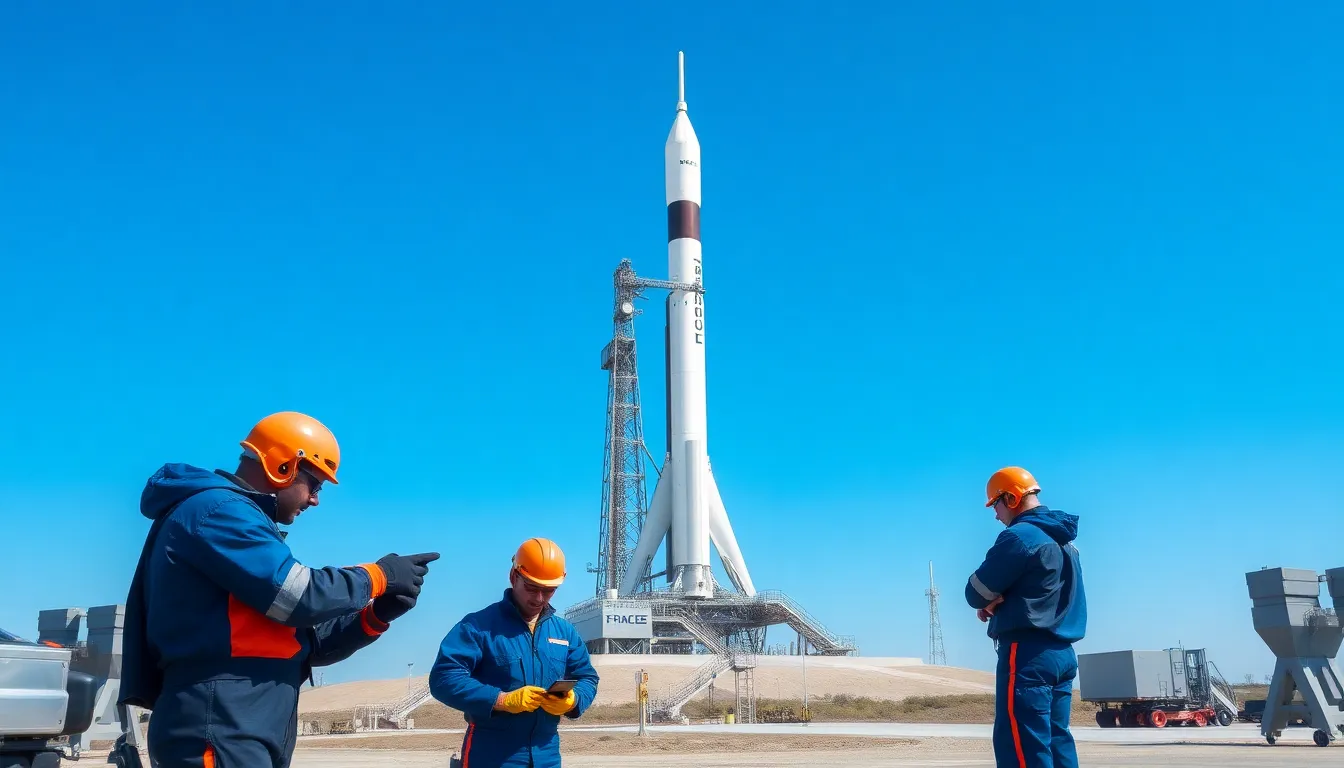When it comes to space technology, the universe is more than just a vast expanse of stars—it’s a playground for innovation. From the satellites orbiting Earth like over-caffeinated squirrels to the rovers exploring Martian landscapes, each type of technology plays a crucial role in our quest for knowledge beyond our planet.
Table of Contents
ToggleOverview of Space Technology
Space technology encompasses various systems and devices developed for accessing, exploring, and utilizing outer space. Communication satellites play a crucial role in global telecommunications, providing services such as television, internet, and weather forecasting. These satellites operate in geostationary orbit, maintaining a fixed position relative to Earth.
Rocket propulsion systems enable spacecraft to escape Earth’s atmosphere. Liquid and solid fuel systems have unique properties that determine their applications in launches and missions. Notably, reusable rockets, such as SpaceX’s Falcon 9, significantly reduce the cost of space travel by allowing multiple launches with the same hardware.
Robotic spacecraft are essential for missions beyond Earth. Rovers like NASA’s Perseverance explore Mars, collecting valuable data to enhance understanding of the planet’s geology and potential for life. Additionally, orbiters such as the Hubble Space Telescope provide unprecedented views of distant galaxies, enriching scientific knowledge.
Human spaceflight technology focuses on enabling astronauts to live and work in space. Life support systems maintain a safe environment, while spacecraft design prioritizes crew health and safety during missions. Space agencies, like NASA, conduct rigorous training to prepare astronauts for the challenges of space.
Each type of space technology contributes significantly to humanity’s exploration of the universe. Innovations continue to emerge, fostering collaboration and advancing our capabilities in both scientific research and practical applications. Managing and improving existing technologies ensures ongoing development, paving the way for future missions and discoveries.
Types of Space Technology

Various types of space technology play vital roles in exploration and research. Each category contributes uniquely to humanity’s understanding of the cosmos.
Launch Vehicles
Launch vehicles represent the backbone of space exploration. These are the rockets used to transport payloads into orbit. Notable examples include SpaceX’s Falcon 9 and the Atlas V, known for their reliability and cost-effectiveness. Reusable rockets, such as the Falcon 9, reduce expenses significantly, allowing more frequent and sustainable launches. Each successful launch advances technological capabilities and paves the way for future missions.
Satellites
Satellites are critical for communication, navigation, and Earth observation. Thousands orbit Earth, providing essential services like GPS and meteorological data. For example, geostationary satellites enable constant communication coverage over specific regions. Low Earth orbit satellites, such as those in the Starlink constellation, offer internet access to remote areas. Increased satellite deployment enhances global connectivity and assists in environmental monitoring.
Space Probes
Space probes are unmanned spacecraft designed to explore celestial bodies beyond Earth. These probes can travel vast distances, collecting data on planets, moons, and asteroids. The Voyager probes, launched in 1977, provide insights into the outer solar system. Newer probes, like the Mars Perseverance rover, examine potential signs of past life on Mars while testing for future human exploration. Missions continue to expand understanding of our solar neighborhood.
Spacecraft
Spacecraft encompass various vehicles for human and robotic exploration. They include crewed vehicles, like NASA’s Orion, designed for missions beyond low Earth orbit. Uncrewed spacecraft, such as the International Space Station, facilitate research in microgravity. Each spacecraft design reflects technological advancements and mission goals, whether for exploration or habitation. Ongoing developments will enable deeper space voyages and eventual manned missions to Mars.
Applications of Space Technology
Space technology plays a crucial role in various fields, enhancing daily life and expanding scientific knowledge. Specific applications include communication, navigation, and Earth observation, vital to modern society.
Communication
Communication satellites enable global connectivity, facilitating phone calls, internet access, and television broadcasts. These satellites function in geostationary or low Earth orbits, providing consistent coverage. Innovations in satellite technology, like miniaturization, improve efficiency and reduce costs. Notable providers, such as Intelsat and Iridium, offer services that connect remote regions. Additionally, advancements in satellite technology support critical infrastructure, enhancing disaster response and emergency communications.
Navigation
Global Navigation Satellite Systems (GNSS) support precise location tracking for various applications, such as transportation and mapping. GPS, GLONASS, and Galileo provide positioning information relied upon by billions of users worldwide. These systems incorporate a network of satellites and ground stations, ensuring accurate navigation in diverse environments. Applications extend to agriculture, where farmers optimize field operations through enhanced accuracy. Furthermore, GNSS technology aids in logistics, enabling efficient fleet management and routing.
Earth Observation
Earth observation satellites gather data critical for monitoring the environment, climate, and natural disasters. Instruments onboard collect imagery and data about land use, vegetation, and atmospheric conditions. Organizations like NASA and ESA utilize this information for research and policy-making. Remote sensing technology assists in tracking climate change and its impacts on ecosystems. Continuously analyzing Earth’s surface helps improve agricultural practices and infrastructure planning, benefiting numerous sectors.
Challenges in Space Technology
Space technology faces numerous challenges impacting exploration and innovation. High costs for development and launches often hinder new projects. Complex engineering requirements demand precision; even minor errors can lead to mission failures.
Reliability remains a critical concern. Launch systems must function under extreme conditions; unexpected malfunctions can jeopardize missions. Ensuring the safety of astronauts during human spaceflight presents additional difficulties. Comprehensive training and advanced life support systems are necessary to mitigate risks.
Environmental factors influence challenges as well. Space debris poses significant threats to operational satellites and spacecraft. Working in a vacuum and extreme temperatures complicates the design and functionality of equipment.
Limited resources also affect research and development. Funding cuts can stall projects; public and private sectors must collaborate to sustain advancements. Knowledge sharing among organizations becomes essential to enhance the efficiency of ongoing efforts.
International cooperation faces political complexities. Aligning interests and goals among various space-faring nations can delay initiatives. Strategic partnerships can yield benefits, yet maintaining collaborative relationships requires commitment and transparency.
Lastly, technological obsolescence creates urgency. Rapid advancements in other fields necessitate continuous innovation in aerospace technology. Keeping pace with developments ensures that space technology adapts to evolving demands and expectations.
Future Trends in Space Technology
Advancements in space technology continue to shape future exploration and research. Innovations in propulsion systems show promise for faster interplanetary travel. Electric propulsion technologies, particularly ion thrusters and Hall effect thrusters, increase efficiency and extend mission durations.
Reusable launch vehicles gain traction as more companies invest in them. SpaceX’s Falcon 9 serves as a leading example with its successful landings and re-flights. This trend emphasizes reduced costs and increased access to space, encouraging new missions and satellite deployments.
Miniaturization in satellite design revolutionizes space missions. Small satellites or CubeSats allow researchers to conduct experiments at a fraction of previous costs. These compact systems facilitate frequent launches and enable greater data collection from diverse environments.
Artificial intelligence plays a crucial role in automation and data analysis. AI assists in spacecraft navigation and decision-making processes, enhancing safety and operational efficiency. Machine learning algorithms provide insights from large data sets generated by space probes and telescopes.
Collaboration among nations fosters shared innovation. Joint missions, such as those by the European Space Agency and NASA, demonstrate collective advancements in technology. International partnerships leverage resources and knowledge, addressing complex challenges in space exploration.
Human spaceflight focuses on long-duration missions, particularly with plans for Mars colonization. Life support systems and habitat designs prioritize sustainable living for astronauts. Research into psychological and physiological impacts supports health and well-being during extended periods in space.
Emerging space economy trends also highlight opportunities. Private enterprises explore space tourism and asteroid mining, opening new avenues for economic growth. This expanding market encourages investment and technological development that fosters further exploration efforts.
Space technology continues to revolutionize how humanity interacts with the universe. Each type of technology plays a critical role in exploration and practical applications, driving advancements in communication, navigation, and environmental monitoring.
The challenges faced in this field highlight the need for innovation and collaboration among nations and private sectors. As new trends emerge, from reusable rockets to artificial intelligence, the future of space technology promises exciting opportunities.
These developments not only enhance scientific research but also improve everyday life on Earth. The ongoing journey into space will undoubtedly shape the next era of exploration and discovery.





